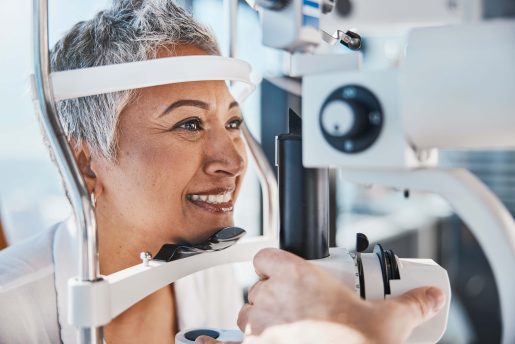Corrective options for aging vision
Worsening vision is normal, especially among adults in their 40s and 50s. In the last decade alone, the field of ophthalmology has seen strides in corrective options for varying vision concerns, such as problems with distance and near vision. Learn more about your options from Baylor Medicine ophthalmologist Dr. Sumitra Khandelwal.
“Our lens is able to accommodate/see a range of vision and overcome plus power when we’re born. As the eyes grow, they develop more normal vision, which is why it’s so important to get your eyes examined when you’re young,” said Khandelwal, professor of ophthalmology at Baylor College of Medicine.
In your 40s, the lens in the eye stiffens and changes shape when looking up-close. The key is to find the sweet spot with glasses or corrective lenses so you can see distance and up-close.
 Eyedrops
Eyedrops
FDA-approved eyedrops are a growing arena that continue to gain popularity for presbyopia. These eyedrops that correct problems with near vision allow you to have a depth of field vision when you would normally need reading glasses, giving you the ability to read up-close for eight to 12 hours. These can be used any time, day or night.
Monovision
Patients who wear contact lenses but feel irritation or bothered when wearing contacts can opt for monovision. Some wear contacts in both eyes as a correction for distance, but some wear one contact lens for the near eye and might not enjoy that.
“We can emulate contact lens monovision with laser procedures such as LASIK, PRK or Smile in order to give them a range of vision, but we also offset their vision and give them monovision so they don’t have to wear reading glasses,” Khandelwal said.
Refractive lens exchange
You might have to start wearing reading glasses in your 40s or 50s due to the lens no longer having that range. In the past, cataract surgery was the only way to correct that issue, but you had to wait until you had a decent sized cataract to be eligible. Now, lenses are available within the realm of lens replacement or refractive lens exchange. Patients are looking for more lens-based options to allow them to have better vision for distance.
“This is an elective surgery where the lens is being removed before a cataract would’ve developed. We put in a new lens implant that’s better than the lens we have in our 50s,” Khandelwal said. “The newer lens can see the range of vision whereas your natural lens at 50 is just not able to do that.”
The new lens technologies are reliable and safe, allowing patients to get this correction earlier in life and avoiding the development of future cataracts.
“Just like with cataract surgery, the eyes change over time, so in the future, you may need a laser touch up to correct astigmatism that would’ve changed or if nearsightedness develops,” she said. “We’re putting implants in patients in their 40s or 50s so there is opportunity for enhancement in the future if that’s what they decide.”
Determining the best option for you
Choosing the correct option for your vision depends on your day-to-day activities. Khandelwal presents patients with a detailed questionnaire and asks them about their favorite activities: Are they outdoors frequently? Do they spend a lot of time in front of the computer? Do they have near hobbies like needle work, porcelain painting or sewing? This allows the doctor to fully understand the patient’s goals for surgery.
An outdoorsy patient who usually does not do near work (such as up-close reading) might not want the risk of glares and halos; they have options to avoid that. Some patients want true near vision, so the trifocal is a good option for them. A popular, new lens technology is the light adjustable lens. A lens will give you near, immediate or distance vision, and a patient might have a difference between their two eyes. The light adjustment takes out the lens and puts in an adjustable lens that gives distance vision initially. Then, patients can do light treatments on it for better immediate or near vision if they tolerate a small difference between two eyes. This is a great option for those who are glare averse as well as for patients who had a previous LASIK or ocular surgery that wants to see again without glasses.
Patients who are nearsighted have longer eyes and are at higher risk for retinal problems. Their risk without surgery is higher than the general population, so they generally should not get refractive lens exchange. Nearsighted patients who are not good candidates for the lens exchange can benefit from other procedures such as LASIK or SMILE.
Those who are farsighted have normal to smaller, shorter eyes who can benefit from the procedure as long as they do not have comorbidities such as retinal problems, glaucoma or cornea problems.
“These lens implants are wonderful, but none of them will make you 20-years-old again, and it’s important to not have that expectation,” Khandelwal said. “The idea of these implants is to give patients a full range of vision they’ve lost due to the aging process of the eye.”
Learn more about Baylor Eye Care.
By Homa Warren

 Eyedrops
Eyedrops

